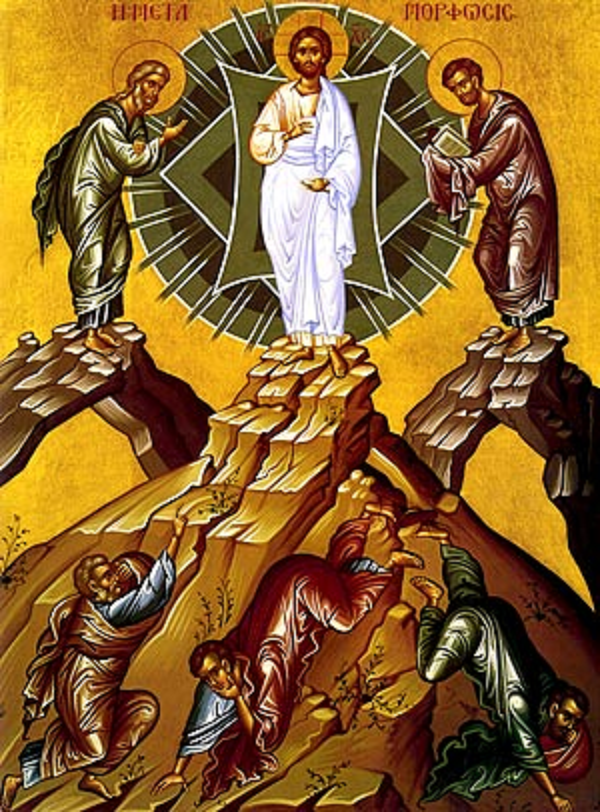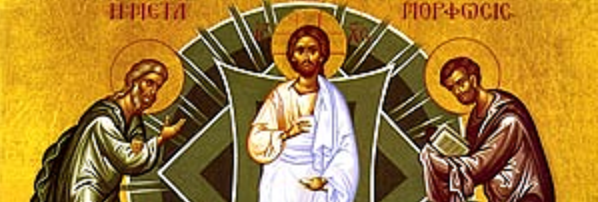Lord, Transfigure Us!
Scripture Readings

The transfiguration of Jesus before Peter, James, and John marks a critical turning-point in the gospel narrative. It’s less than ten verses long, yet it’s incredibly densely packed with symbolism and meaning. The gospel places the transfiguration immediately after Peter’s profession of faith in Jesus as the Messiah and Jesus’s prediction of his suffering and death. Likewise, it places it immediately before Jesus sets out on his final journey to Jerusalem. There’s an unmistakable echo in the voice from the cloud of the voice that spoke at Jesus’s baptism in the Jordan by John. Just as that first voice marked a turning point from Jesus’s private life to his public ministry, so this second voice marks the turning point from his public ministry of preaching and teaching to his mission as Suffering Servant and Savior.
What happened with the disciples on the mountain? We’ll never know. Apparently, they were asleep for much of it. All we know for certain is that they had a profound spiritual experience that changed forever their understanding of and appreciation for Jesus. Something happened. That “something” was remarkable enough that, when they spoke and wrote about it later, it had given them a unique perspective on Jesus and his role in the history of salvation. They literally saw him differently.
It reminds me of the transfiguring power of love. We all project to others an idealized, sanitized version of ourselves. We want to be seen as the people we hope to be, rather than who we really are. The Greeks called this idealized image we project our persona. Per-sona means sound booster, or, what we’d call a megaphone. The mask amplified the actors’ voices as well as indicated the role they were playing. Because we all have a persona, we can know people for many years and live and work side-by-side with them and still never see much more than their masks…that is, until love comes along.
The power of love is such that it can strip away the persona. People show themselves as they really are, with all their warts and blemishes. They show their brokenness, and we can finally see the genuine image of the other through the eyes of love. Infatuation idealizes the other, but true love sees the reality of the other without judgment and without condemnation. Lovers create a safe space for one other to be themselves.
We have to imagine that something like that is what happened to the disciples on the mountain. They’d been disciples of Jesus for a couple of years already, and, suddenly, they experienced Jesus as never before. Although they couldn’t possibly have grasped the full grandeur of his being before they experienced the Resurrection and coming of the Holy Spirit, they at least recognized that he was so much more than they had ever imagined. They called that “something more” his glory.
The transfiguration was a transcendent event. It happened in what I call “sacred space” and “sacred time.” We know that, for Saint Luke, the mountain was where Jesus went to commune with the Father. It was where Jesus encountered his “burning bush” most intensely and intimately. As he approached this turning point in his life, Jesus sought to align his will with that of his heavenly Father. It was a foreshadowing of Gethsemane. Into that moment came Moses and Elijah—the Law and the Prophets. Through the voices of the Sacred Scriptures, the Father spoke to the Son about “what he was going to accomplish in Jerusalem.” They spoke to him about his exodus—his Passover—his death and Resurrection—the culminating event of the entire history of God’s people, encompassing it and bringing it to completion. Yet, the disciples were deeply asleep.
They awoke to a startling vision. Evidently, they saw—whether it was with their physical eyes or the eyes of faith—Moses and Elijah—the Law and the Prophets—with Jesus in their midst as one of them. Though their understanding was necessarily limited, they grasped enough to see that Jesus was no less an important figure than the two greatest prophets of Jewish history.
I’ve been aware for a long time that Peter wanted that vision to last. He wanted to set up three tents so that the three great prophets could dwell there as God had dwelt with his people in a tent in the wilderness. And, of course, he himself and James and John could stay with them in their presence. It’s our instinct to hang on to seminal experiences—especially spiritual ones—and never have to go back to the mundane world. I knew that. I get it. Peter’s tents make sense.
What I recently learned was the connection between the three tents that Peter wanted to pitch and the Jewish festival of Succoth, which we refer to as the Feast of Booths or the Feast of Tabernacles. The connection to this feast must have occurred to the disciples after the Resurrection. The Feast of Booths originated with the people of Israel wandering in the desert in tents. When they had settled in the Promised Land, they used the festival to commemorate that time in the desert by setting up tents and living in them for eight days every year. It was one of the three most important festivals of the Jewish year, along with the Passover and the Day of Atonement.
Succoth had three other important connections to Jewish history and practice. It took place in the fall, so it was a harvest festival when the first fruits of the fields and flocks were brought to the temple to be offered to God in thanksgiving. That made it the last great festival before the onset of bleak winter and the fallow time before the spring planting.
Secondly, it commemorated Yahweh God’s presence among his people, first of all, in the meeting tent as they wandered the desert. Then, God’s presence was celebrated during this festival in whatever places God was worshipped. Finally, King Solomon chose the Feast of Booths for the dedication of his temple in Jerusalem—a dedication that was celebrated during this feast every year thereafter.
Finally, the annual reading of the Torah concluded at the Feast of Booths. And, every seven years, the Torah was read aloud at this time in its entirety. Therefore, the festival was the opportunity provided every year for the people to rededicate themselves to their Covenant with God.
How does this fit in with the transfiguration, and what does it have to do with us? After the Resurrection, the disciples could look back at their experience of the transfiguration on the mountain and see the joy it brought to them, even as they were about enter the spiritual winter of suffering and death. The hope of the Resurrection was on the horizon like the promise of the coming of new life in the spring. They could also see the presence of Yahweh God in the whole of that experience and find gratitude to God—Eucharist—even at the threshold of suffering. They could appreciate the new Covenant God was offering them, inviting them to follow his Son—the Chosen One—in his Passover from suffering and death to Resurrection and new and eternal life.
There’s a lot there to ponder. I know. But here’s where it all comes together. We take this opportunity each year during the season of Lent to reconnect with the faithfulness of our heavenly Father as Jesus did on the mountain. We experience Jesus again transfigured before us, not as an historical persona, but as he really is: God with us, God among us, seen only with the eyes of faith and love. We accept at this turning point in our lives to set our feet on the path of anamnesis—of living once more the suffering, death, and Resurrection of Jesus. And we make this our eucharist—our thanksgiving—for all God has done for us.
It is the gift of the Holy Spirit that empowers us to be transfigured. Delivered from fear, we can be free to be ourselves. We can face suffering and death with faith in the power and loving kindness of our God. We can live in gratitude regardless of our situation. We can offer this sacrifice of thanksgiving—this Eucharist—because today our Father speaks to us as he spoke to Jesus on the mountain: “You are my chosen son. You are my chosen daughter.”
Get articles from H. Les Brown delivered to your email inbox.
